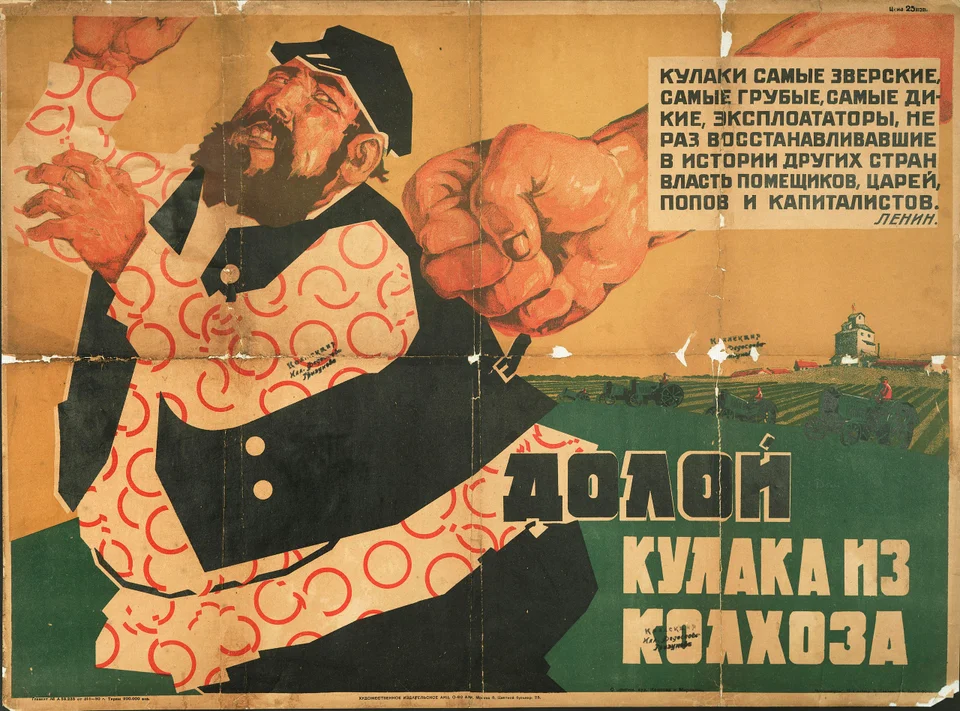More languages
More actions
mNo edit summary Tag: Visual edit |
(History) Tag: Visual edit |
||
| Line 1: | Line 1: | ||
[[File:Anti-kulak poster.png|thumb|"Oust the kulak from the [[kolkhoz]]"]] | [[File:Anti-kulak poster.png|thumb|"Oust the kulak from the [[kolkhoz]]"]] | ||
'''Kulaks'''<ref group="lower-alpha">Russian: Кулак; Ukrainian: Куркуль; Azerbaijani: ''qolçomaq''</ref> | '''Kulaks,'''<ref group="lower-alpha">Russian: Кулак; Ukrainian: Куркуль; Azerbaijani: ''qolçomaq''</ref> '''kulaki''', or the '''kulachestvo''' were wealthy landowners in the [[Russian Empire (1721–1917)|Russian Empire]] and early [[Union of Soviet Socialist Republics (1922–1991)|Soviet Union]]. They exploited the poor [[Peasantry|peasants]] and forced them to work on their farms.<ref name=":1">{{Citation|author=[[Joseph Stalin]]|year=1939|title=History of the Communist Party of the Soviet Union (Bolsheviks)|chapter=The Struggle for the Creation of a Social-Democratic Labour Party in Russia|chapter-url=https://www.marxists.org/reference/archive/stalin/works/1939/x01/ch01.htm|mia=https://www.marxists.org/reference/archive/stalin/works/1939/x01/index.htm|title-url=http://www.marx2mao.com/Other/HCPSU39NB.html}}</ref> Kulaks made up 5% to 7% of the rural population.<ref name=":052">{{Citation|author=Ludo Martens|year=1996|title=Another View of Stalin|chapter=Collectivization|isbn=9782872620814|publisher=Editions EPO|pdf=https://gateway.ipfs.io/ipfs/bafykbzaceab64vxtxpqt2cdl4zsrsftmedqidn4foq74gr25qkd35z5nwogdi?filename=Ludo%20Martens%20-%20Another%20View%20of%20Stalin-Editions%20EPO%20%281996%29.pdf|page=46–50}}</ref> | ||
== History == | == History == | ||
=== Russian Empire === | |||
The kulaks emerged in the 1860s after Tsar [[Alexander Nikolayevich Romanov|Alexander Nikolayevich]] abolished [[serfdom]]. By 1903, 500,000 kulak households controlled as much land as almost ten million peasant households.<ref name=":1" /> | The kulaks emerged in the 1860s after Tsar [[Alexander Nikolayevich Romanov|Alexander Nikolayevich]] abolished [[serfdom]]. By 1903, 500,000 kulak households controlled as much land as almost ten million peasant households.<ref name=":1" /> | ||
=== New Economic Policy === | |||
The first collective farms in the Soviet Union were created during the [[New Economic Policy|NEP]], but the majority of peasants continued to work their own land. Kulaks controlled many farming cooperatives during this period and even took over some local [[Soviet (governmental body)|soviets]]. In 1926, the kulaks controlled at least 20% of market wheat while collective farms only controlled 6%. Following a bad harvest in 1927, the kulaks hoarded grain in order to create a price hike. The government imposed new taxes on kulaks, restricted the number of workers they could hire, and established quotas on grain collection. Village soviets could seize kulaks' land if they did not meet these requirements.<ref name=":052" /> | |||
=== Collectivization === | === Collectivization === | ||
| Line 13: | Line 18: | ||
== References == | == References == | ||
<references /> | <references /> | ||
[[Category:Social class]] | |||
[[Category:History of the Soviet Union]] | |||
Revision as of 20:53, 19 February 2023

Kulaks,[a] kulaki, or the kulachestvo were wealthy landowners in the Russian Empire and early Soviet Union. They exploited the poor peasants and forced them to work on their farms.[1] Kulaks made up 5% to 7% of the rural population.[2]
History
Russian Empire
The kulaks emerged in the 1860s after Tsar Alexander Nikolayevich abolished serfdom. By 1903, 500,000 kulak households controlled as much land as almost ten million peasant households.[1]
New Economic Policy
The first collective farms in the Soviet Union were created during the NEP, but the majority of peasants continued to work their own land. Kulaks controlled many farming cooperatives during this period and even took over some local soviets. In 1926, the kulaks controlled at least 20% of market wheat while collective farms only controlled 6%. Following a bad harvest in 1927, the kulaks hoarded grain in order to create a price hike. The government imposed new taxes on kulaks, restricted the number of workers they could hire, and established quotas on grain collection. Village soviets could seize kulaks' land if they did not meet these requirements.[2]
Collectivization
In 1929, the Soviet government banned renting land and private hiring of labor. It allowed peasants to expropriate kulaks and take their cattle, machines, and other farming equipment to use in collective farms. During collectivization, they burned crops and destroyed farm equipment.[3] They also killed millions of livestock; the number of horses decreased from 30 million to under 15 million, cattle decreased from 70 million and 31 million, goats and sheep decreased from 147 million to 50 million, and hogs decreased from 20 million to 12 million.[4] The Soviet rural economy did not recover from the kulaks' sabotage until after the Great Patriotic War. By 1936, the kulaks had been completely eliminated.[5]
Notes
- ↑ Russian: Кулак; Ukrainian: Куркуль; Azerbaijani: qolçomaq
References
- ↑ 1.0 1.1 Joseph Stalin (1939). History of the Communist Party of the Soviet Union (Bolsheviks): 'The Struggle for the Creation of a Social-Democratic Labour Party in Russia'. [MIA]
- ↑ 2.0 2.1 Ludo Martens (1996). Another View of Stalin: 'Collectivization' (pp. 46–50). [PDF] Editions EPO. ISBN 9782872620814
- ↑ Walter Duranty (1949). Stalin & Co. New York City: W. Sloane Associates.
- ↑ Ludu Martens. Another View of Stalin (p. 108). [PDF] Stalin Society.
- ↑ Joseph Stalin (1939). History of the Communist Party of Soviet Union (Bolsheviks): 'The Bolshevik Party in the Struggle for the Collectivization of Agriculture'. New York: International Publishers.
